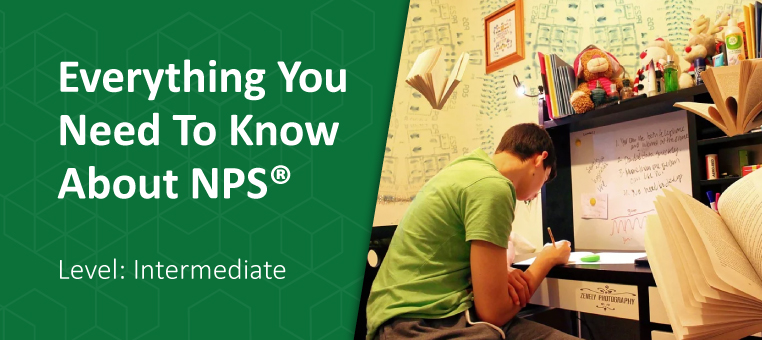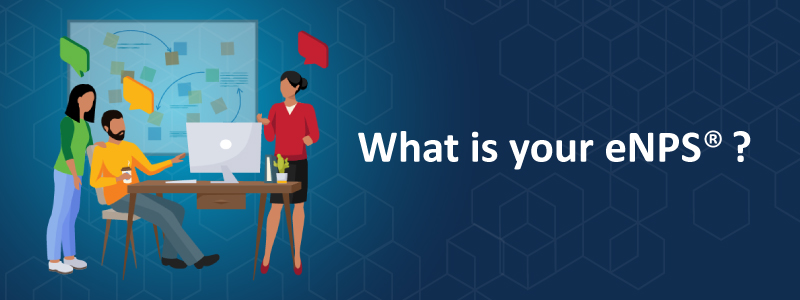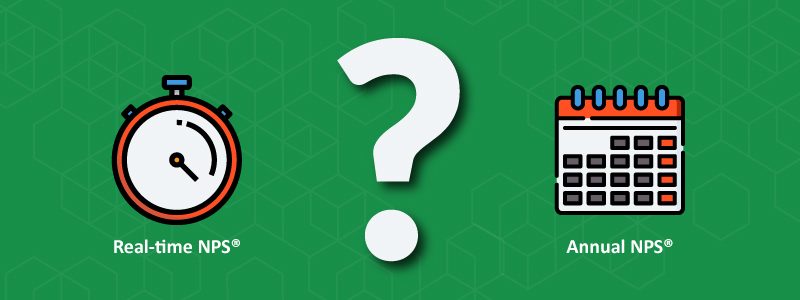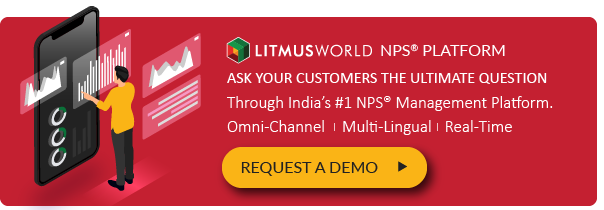The Ultimate Guide to the Net Promoter Score® (NPS): Intermediate Level
Everything You Need To Know About NPS®! (Level Intermediate)

8 minute read
The Ultimate Guide to the Net Promoter Score (NPS) is designed for all (Beginner, Intermediate, Proficient and Expert) levels of NPS® practitioners. The aim of this guide is to consolidate everything you need to know about the Net Promoter Score/Net Promoter System on a single platform.
This guide encompasses everything from understanding to implementation to the success of NPS® initiatives. The guide is divided into 4 parts to make it easier for you to come back and continue reading from where you left-off. You are currently reading the ‘Level: Intermediate’ guide to NPS®.
At the end of the 4-part guide is a quiz that you can take to test your knowledge and learnings from this guide. Happy upskilling!
Before we begin, here is a quick disclaimer about the Net Promoter Score/System®:
Net Promoter, Net Promoter Score and NPS® are registered trademarks of Bain & Company, Inc., Fred Reichheld and Satmetrix Systems, Inc. All titles, content, publisher names, trademarks, artwork, and associated imagery are trademarks and/or copyright material of their respective owners.
With that said, let’s begin our journey towards dramatic improvements!
In this section:
- What is eNPS®?
- Is NPS® really worth it?
- Real-time NPS® measurement or Annual/One-Time NPS® Measurement?
- How do I design an NPS® Questionnaire?
- 3 success-pillars to the Net Promoter System®
Q6. What is eNPS®?

Engaged employees create engaged customers. If your employees are motivated and engaged, they offer superior customer service and create memorable customer experiences, which in turn creates brand advocates. This forms the basis of the service-profit chain.
Employee Net Promoter Score is derived from Net Promoter Score®, a customer service tool to gauge customer loyalty. It measures the likelihood of an employee recommending your place of work or the products you sell to their friends and family. It helps you understand what your employees like or dislike about working for you.
eNPS® helps you measure employee loyalty and can be measured using a 3-screen or a 3-question approach as we call it-
- The first screen is the NPS® questions: “How likely are you to recommend <your company> as a good workplace to your friends/family?”
- The second screen is all about asking “Why?”. We are happy/sad to see your rating. Could you help us understand the reason for your rating? (followed by an open text field)
- The third screen should ask them for their opinion. No matter how junior in the organization, we all have opinions on how we can make the organization better. You may just find the pin in the hay-stack. Ask them “What could we do better to help you with your productivity?” (Again, followed by an open-text field)
Loyal employees work harder. They believe in what you are doing and are actively involved in going above and beyond what their duties require them to do. They are constantly brainstorming ideas that can help your organisation grow. And it is not a stretch to see them more engaged your employees are, the more productive they are, the more they care for their customers which ultimately leads to the ROI we so love. Apart from this, loyal employees stay with you longer. This means reducing employee turnover costs that can be both financial and emotional as it can affect the morale of the organisation.
Read more about the one number that nobody is talking about – eNPS!
Q7. NPS® has a lot of criticism. Is NPS® really worth it?
Net Promoter Score (NPS®) is one of the most popular metrics being used in business today. And while NPS® has many supporters to sing its praises, there seems to be an equal number of critics who have emerged to decry it, citing a number of reasons why it should be abolished. Among these debates, misconceptions have emerged from both sides.
I often get asked/suggested the following statements, which in my opinion are totally false:
Myth 1: NPS® should be practised exactly as proposed 15 years ago.
Myth 2: Since NPS® is about capturing emotions, it is more suited for relationship assessments, and not for assessing touchpoints experience.
Myth 3: External benchmarking of company NPS® is critical.
Myth 4: NPS® is only good for measurement and has no actionability.
I have debunked these myths in detail in the article here: Decoding NPS Myths
Q8. What is better: Real-time NPS® measurement or Annual/One-Time NPS® Measurement?

Technology has changed customer expectations by leaps and bounds. Customers interact with brands through a multitude of channels and expect brands to deliver a consistent experience across each channel, be it a physical outlet or a website. These channels bring in unprecedented complexity across the customer journey. According to Marketing Week, consumers today use an average of almost six touchpoints across the journey, with 50% regularly using more than four.
Considering the sheer volume of interactions and complexity, traditional/One-Time/Annual NPS® measurement strategies are ill-equipped to capture the experiences of customers across the journey for the following reasons:
- Low frequency of measurement
- Lack of actionability
- Lack of context
Fortunately, while customers have access to brands across all channels, brands have access to customers as well. Technology makes it possible for brands to reach out to customers immediately at the moment of experience, making measurement of NPS® possible in real-time.
Why does real-time need to be the cornerstone for NPS® measurement? For the reasons below:
- Real-time enables room for more actionability
- Real-time NPS® measurement is more accurate
- Real-time NPS® data enables continuous improvements
In short, real-time measurement of CX provides you with data that is accurate and contextual, insights that are actionable and metrics that showcase how customer-centric your brand really is, minute-by-minute or even second-by-second.
One of our subject matter experts talks in detail about Real-Time v/s Annual NPS® measurement here.
Q9. How do I design an NPS® Questionnaire?
Ask the right NPS® question to get a constant pulse on your customer satisfaction and you will gain an accurate understanding of how your company, product or service is perceived. Designing an NPS® Questionnaire is an art. A real artist knows to ask just the right amount of questions. Nothing more; nothing less.
LitmusWorld preaches a 3 screen approach where our intention is to reduce the time taken by the respondents in providing the feedback. Reducing this time results in significantly lower drop-offs and over 85% of the respondents complete the entire questionnaire.
The three-screen approach helps in capturing the 3 key elements of customer experience:
- Emotion
- Rationale
- Expression
The basics of designing a questionnaire are asking contextual and relevant questions. For example, if a customer is a passive ask him relevant questions and if a customer is a super promoter ask him to appreciate the experience owner. While every business is different and so is every touchpoint, here is a generalised framework of designing an NPS® questionnaire:
Q1. Based on your recent experience with <your brand name>, how likely are you to recommend us to a family or a friend? (Followed by a LitmusWorld wheel or a 0-10 scale neutral rater)
Based on the answer to this question ask the following conditional questions to the respondent:
Super Detractors
Q2. Please highlight your issue in detail here and we will get back to you with a resolution in the next 2 hrs. (Followed by an open text field)
Detractors
Q2. We’re really sorry to hear that! Please select the service delivery factors you were unhappy with: (followed by a multi-select list of experience influencers such as ambience, staff, product, so on and so forth)
Q3. We shall make sure we work on providing you with a better experience in the future. Please highlight the areas of improvements here: (followed by an open text field)
Passives
Q2. We’re sorry to hear that we couldn’t live up to your expectations. Kindly highlight the areas where we could’ve done better: (followed by a multi-select list of experience influencers such as ambience, staff, product, so on and so forth)
Q3. Kindly highlight the areas where you think we did good: (followed by a multi-select list of experience influencers such as ambience, staff, product, so on and so forth)
Promoters
Q2. We’re glad you liked us. What did we miss to deserve a 10/10 score? (followed by an open text field)
OR
Q2. Yay! We shall pat our backs for this. Kindly share your thoughts on what did we miss to deserve a 10/10 score. (we shall add your feedback to our wall-of-appreciations) (followed by an open text field)
For a detailed rationale behind asking each of these questions and other questionnaire design hygiene, head over to this article where I have answered the question How to design an NPS® questionnaire in greater detail.
Q10. What are the 3 success-pillars to the Net Promoter System®?

Measure, Act and Improve form the 3 success-pillars in implementing the Net Promoter System® and managing customer experiences. LitmusWorld’s proprietory and registered M.A.I. Measure, Act & Improve® framework enables enterprises to Measure, Act and Improve business processes through contextual conversations that deliver actionable insights.
- “Measure” helps in improving the active engagement rate
- “Act” aims at enabling experience owners to take corrective actions at the right moments and close-looping with customers
- “Improve” provides actionable insights through text analytics, trend analysis, quintile and top/bottom 2 analysis followed by granular visibility into individual experience owners performance through a real-time dashboard.
Take a deeper look into the M.A.I.® framework.
‘M.A.I.’ and ‘Measure, Act & Improve’ are registered trademarks of LitmusWorld. ©2020 LitmusWorld Marketing Technologies Private Limited.
Now that you’ve successfully completed the ‘Level: Intermediate’ guide, let’s move to the ‘Level: Proficient’ guide to NPS®.



